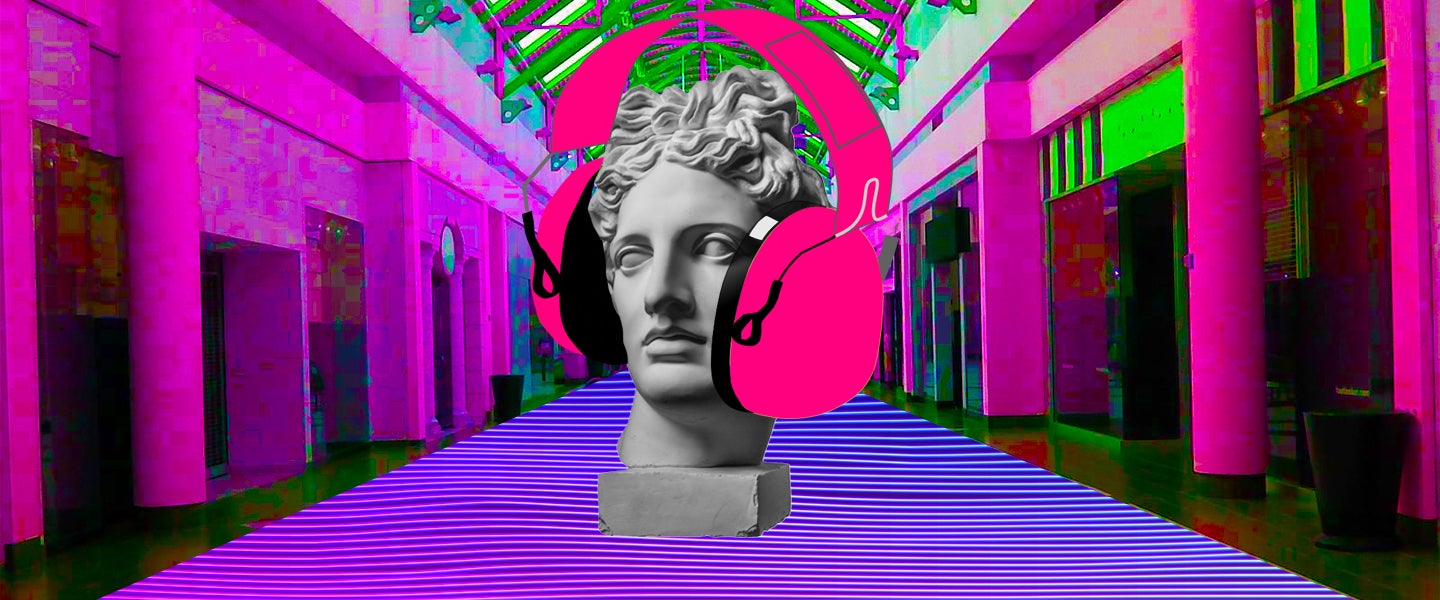When Michael Tills from Kentucky wants to escape, he goes to the mall. He visits the old ice cream parlor and orders his favorite: mint chocolate chip with a scoop of bubblegum. Tills heads over to the skateboard store where he used to buy chunky DC sneakers and griptape for his board. He stops by the water fountain at the center of the mall, the place where he took his first date and had his first kiss. The mall is a happy place, reminiscent of a time when he was younger and carefree — where his life played out to a soundtrack of Weezer, No Doubt and the Counting Crows.
Except, Tills never experienced such a mallrat adolescence. In fact, the closest mall to his home, the Fayette Mall in Lexington, is so small that you could probably visit every store in under an hour. And being born in 1999, his friends are more likely to be listening to Drake, A$AP Rocky, XXXtentacion, or more commonly, the artists that appear on Spotify’s curated playlists.
Indeed, Tills’ life at the mall is imaginary. He’s nostalgic for the 1990s, which he thinks was a better time to live. At the core of this mental construction is “mallwave,” a lo-fi subgenre of vaporwave that listeners refer to as “music optimized for abandoned malls.” Like Vaporwave creators, Mallwave musicians use soft drum tracks, ambient sounds and low-quality synthesizers to create soft, calming electronic music. But they also mix in pop music associated with the 1970s, 1980s and 1990s, with the purpose of creating a holistic “nostalgic” experience, one that recreates the experience you would have had when visiting the mall. Or, in Tills’ case, what that experience might have been like, for people who lived it.
I contacted Tills through YouTube, where he listens to mallwave streams. Though he says he’s a fan of all genres of music, he tells me none of them compare to Vaporwave. “I have different emotions when I listen to it,” he explains. “I feel like I’m in a completely different time, but that I belong there. I feel like I’m reliving moments of my past, even though I know, logically, that I didn’t. It’s weird, but it’s also really calming.”
For Tills, the music invokes a “sensory” kind of nostalgia that he doesn’t get from the music of his childhood. “That’s the appeal of vaporwave,” he says. “It can take you to a place you’ve never been before, but still make you feel at home.”
It’s a sentiment many others share. “The nostalgia is so real you can cry and wish you went back in time,” reads one comment underneath the video “Neon Wave Mall (Vapor Mix).” “I feel a certain sense of… familiarity watching this footage. Almost like I myself have set foot in these places,” adds a viewer of “Corp Palm Mall.” Under the same video, another person opines: “Why wasn’t I born in this time? This video makes me realize how much things were not as advanced as we have now but it was better. I could be wrong, but sometimes I feel like living around the ‘90s sounds fun. Lifestyle is different, mindset is different and not as much laziness.”
According to writer Joe Koenig, this kind of feeling — a “nostalgia for a past you’ve never known” — is called anemoia. In his ongoing project, The Dictionary of Obscure Sorrows, Koenig describes it as “the desire to wade into the blurred-edge sepia haze that hangs in the air between people who leer stoically into this dusty and dangerous future.”
Such a universal “nostalgic” feeling, though, isn’t without its drawbacks. Namely: Spending too long in a state of artificial nostalgia can lead people to much darker emotional places. Speaking to the British magazine Drugstore Culture, Koenig says, “It’s a nostalgia for shopping trips with your mom when you were just a little kid, with tinny Madonna playing in the background. But the unease arises when that background noise becomes the only sound around, and gets your full attention. It can make you feel like you’re somewhere you don’t belong, like you’re locked in after hours. Some people also say it makes them feel like they’re in the apocalypse.”
For his part, Tills mallwave passion has yet to become apocalyptic. That said, he does believe that there’s truth to the general feelings of uneasiness in wider society — the very feelings that led him and others in their late teens and early 20s to vaporwave communities. “It’s not just the music, it’s also the aesthetic that comes with it,” he says. “The imagery is cleaner, its brighter and it’s more calm.” He points me to videos made by Cecil Roberts — among the leaders in YouTube’s mallwave genre, who sets his mixes to images of empty malls with bright purple neon lights — and Zadig the Jasp, whose vaporwave album is, according to Tills, best listened to while looking at the running video of a mall, covered in palm trees, with two empty, rolling escalators.
“It sounds stupid, but mallwave does let me escape from the shittiness of everyday life,” Tills explains. “It’s just a couple of hours in a day where everything at least feels okay, that I don’t have to worry about whether or not I’m going to get a job, the political situation in the U.S. — all that shit. I guess it makes me think that there was a better time, or a time when people in this country felt better.”
There is, of course, a current of anti-capitalist sentiment in mallwave. Artists like Infinity Frequencies, MEDIAFIRED and 情報デスクVIRTUAL purposely use outdated, cheesy 1980s pop samples as a way of critiquing the origins of modern Western capitalism, mirroring the “irony” of hipsters who, in the words of music journalist Simon Chandler, “made the flawed world around them bearable not by changing it, but by treating its flaws as something to be laughed at from afar.”
In fact, as Chandler goes on to say, vaporwave artists like INTERNET CLUB use mallwave to critique late capitalism not just in its music, but also its aesthetic. The band’s album VANISHING VISION — one of the most notorious in the vaporwave scene — “never include a picture of their creators or even actual human beings”; instead, they present pristine, empty malls. The idea, Chandler says, is that the music creates an “enlightened, permissive environment, where personal identity is null. Instead, the media and the objects we consume determine our worth.”
To Grafton Tanner, author of Babbling Corpse: Vaporwave and the Commodification of Ghosts, the turn to nostalgia in vaporwave is all about this reflection of contemporary societal trends — whether it’s grappling with late capitalism or dreaming of an allegedly sunnier bygone era. Speaking over Skype, he tells me, “Nostalgia is a popular tool in marketing, and it’s probably the most defining cultural product of our time. You see it in movies and TV with reboot trends, and of course, apps like Spotify use algorithms that recommend music that you’ve probably listened to in the past.”
“Much of it is related to how we use the internet today,” he continues. “On social media, you have access to nostalgia at your fingertips. You can be recommended old photos or Facebook posts that can invoke memories, or sometimes, when you want to remember a better time, you can scroll back to old photos. So in a lot of ways, the way we use the internet is partly rooted in nostalgia, and you can read vaporwave as a genre that reflects that moment of time.”
All of which makes nostalgic feelings evoked by vaporwave appealing — if not addictive — to a generation that grew up on the internet. “You have a generation who live in uncertain times, and the danger of this kind of music is that it doesn’t take long for someone who, in a state of intense nostalgia, can be manipulated into thinking that we should return to the past when things were better,” he says. “You’ll have people who think things were better in the past because they were more stable and fixed. And people in more dangerous vaporwave communities like the far right — who have their own vaporwave community known as ‘fashwave’ — can say, ‘Yes, in the past, things were better when there wasn’t gender or racial equality.’ That yearning for the past — for a better time — can lead to people forming their politics based on misremembering.”
Tills doesn’t think vaporwave could send him down a political rabbit hole anytime soon, but when I speak to him again, he does admit that Tanner has a point about looking to mallwave, and vaporwave more generally, to a past that isn’t necessarily reality. “I can imagine a time when people talked to each other, got on well,” he says. “Maybe it’s fantasy. Maybe it’s not accurate in real life. But it’s better compared to the way we’re living now.”

